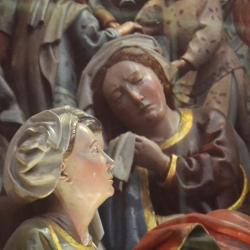Catalogue
THE PASSION ALTARPIECE
STYLE
The predominant feature of this altarpiece is its dense, complicated composition that uses several groups to form one large scene depicting several biblical episodes in a continuous, uninterrupted sweep.
Despite the fact that the re-applied Baroque polychrome decoration rather masks the original work, we can still observe certain characteristics attributed by Guillot de Suduiraut that substantiate the altarpiece having been manufactured in a workshop active in Brabant between 1450 and 1470. The work's most revealing characteristics include the physical features of women's faces with their fleshy faces above solid necks, large eyes, small straight noses reaching their eyebrows - which are sometimes set in wrinkled frowns in order to transmit pain - wide mouths with thin lips and hair with partings that falls in waves over their ears.
This characteristic style has also been identified by the way in which compact, weighty fabrics form many pleats and folds when they touch the ground. The figures, however, have not been executed in great detail and are surrounded by rounded frames. The folds are not deep and have rounded profiles.
.png)
.png)
